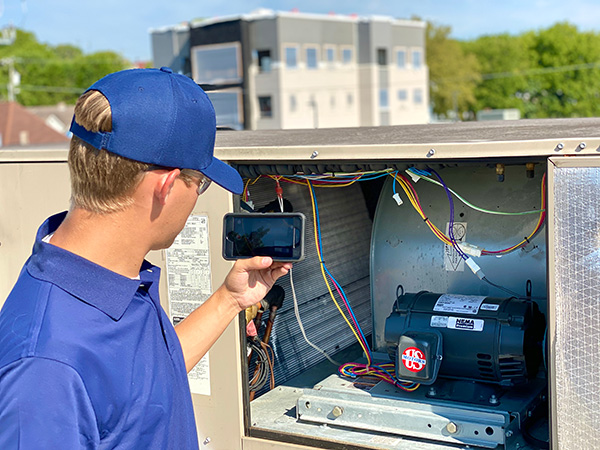For HVAC OEMs, it’s crucial to know how systems perform even post-installation. Robust data and analytics can help.
By JP Cahalan
According to the Office of Energy Efficiency & Renewable Energy, three million heating and cooling systems are replaced and $14 billion is spent on HVAC services and repairs annually, and each dollar spent on those repairs has data points attached to it.
Data collected from digitized work orders and inventory management connect original equipment manufacturers (OEM) with their products in the field more than ever before. By gaining access to repair records captured by intelligent field service software, OEMs receive invaluable information, such as:
When implemented correctly, this information can help OEMs make strategic decisions in replacement part and whole-unit equipment manufacturing to boost the serviceability and reliability of their HVAC systems.

HVAC service companies are finally leaving the days of pen and paper behind to adopt a more tech-based approach to day-to-day operations. Rather than recording everything by hand, modern software allows technicians to use their mobile devices for diagnosing issues, logging live data from necessary repairs, ordering parts and creating a digital record of invoiced parts and labor.
When field service companies work in an ecosystem that shares live data with OEM, manufacturers can keep their finger on the pulse of their equipment in the wild.
This consistent data stream gives companies invaluable insights into reliability and lifespan, and it also makes it possible for manufacturers to make the pivots necessary to improve operations, streamline revenue streams, and stay ahead of the competition.
When properly implemented, field data works as a key to unlock better manufacturing and distribution systems. Refining your data collection process benefits the OEM in three crucial areas: software improvements, quality control and supply chain.
Software updates may not be the first thing that comes to mind when improving the manufacturing process for HVAC companies. However, HVAC systems are becoming increasingly dependent on software to run properly. Technician data pulled from smart home connected systems can help OEM teams figure out if hardware or software adjustments are the cause of system failures.
For instance, field data could point toward premature compressor failures caused by compressors running at higher-than-average pressures due to improper parameters programmed into the system. Software updates could resolve this issue by installing new pressure parameters without a replacement part, preventing future compressor replacements in the future.
Predictive quality control happens by pairing field data with statistical modeling to reveal potential product trends. HVAC products undergo rigorous testing before they ever leave the plant, but there is always a chance that they will fail after running day-in and day-out. Leveraging a database of logged service information will help you track and predict trends that can lead to adjustments in the manufacturing process, such as a part redesign, which prevent failures in future models.
Implementing predictive quality control measures can also help manufacturers give repair companies more accurate maintenance and repair timelines. Manufacturers can offer better insights into what may fail, and when, to inform service providers of what they should include in preventative maintenance packages for customers.
Supply chain management issues are often data management issues. Without consistently updated information from the field, it is challenging to tell what parts are necessary to keep existing units running. Collecting live data and analyzing trends will help manufacturers produce enough parts necessary to manage the load for repairs and prevent supply chain disruptions.
Properly stocked warehouses prevent supply chain issues, like nationally backordered products, which leave consumers without a running HVAC system and often cost companies repeat business. Understanding replacement part demand also prevents manufacturers from producing too many parts with a longer lifespan.
By implementing data-driven changes to quality control and supply chain practices, OEM companies can also optimize revenue control. Increased efficiencies throughout the pipeline improve OEMs’ bottom line by:
Ultimately, acquiring and properly implementing field data could be a solution to issues that all OEM HVAC companies face. They can better understand what happens to their product once it’s installed into customer homes and businesses and gain invaluable insights into how they can adjust processes to streamline operations and maximize profit.

About the Author:
J.P. Cahalan is senior process engineer at XOi. He’s responsible for helping customers find multi-layered value and success with the XOi platform. Believing that change is something that is necessary for businesses to grow, J.P. has an acute understanding of customer behavior, and knows that change is not something that should be taken lightly.
In this episode, I sat down with Beejan Giga, Director | Partner and Caleb Emerson, Senior Results Manager at Carpedia International. We discussed the insights behind their recent Industry Today article, “Thinking Three Moves Ahead” and together we explored how manufacturers can plan more strategically, align with their suppliers, and build the operational discipline needed to support intentional, sustainable growth. It was a conversation packed with practical perspectives on navigating a fast-changing industry landscape.